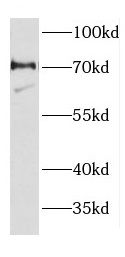Products
DEAF1 antibody
| Synonyms: | Deformed epidermal autoregulatory factor 1 homolog|Nuclear DEAF-1-related transcriptional regulator (NUDR)|Suppressin|Zinc finger MYND domain-containing protein 5|DEAF1|SPN|ZMYND5 antibody | ||
| Catalogue No.: | FNab02320 | Reactivity: | Human, Mouse, Rat |
| Host: | Rabbit | Tested Application: | ELISA, WB, IHC |
| Clonality: | polyclonal | Isotype: | IgG |
| Size | Price |
|---|---|
| 100µg | Inquiry |
- SPECIFICATIONS
- FIGURES
- CONDITIONS
- FAQS
- Product Name
- DEAF1 antibody
- Catalogue No.
- FNab02320
- Size
- 100μg
- Form
- liquid
- Purification
- Immunogen affinity purified
- Purity
- ≥95% as determined by SDS-PAGE
- Clonality
- polyclonal
- Isotype
- IgG
- Storage
- PBS with 0.02% sodium azide and 50% glycerol pH 7.3, -20℃ for 12 months(Avoid repeated freeze / thaw cycles.)
- Immunogen
- deformed epidermal autoregulatory factor 1(Drosophila)
- Alternative Names
- Deformed epidermal autoregulatory factor 1 homolog|Nuclear DEAF-1-related transcriptional regulator (NUDR)|Suppressin|Zinc finger MYND domain-containing protein 5|DEAF1|SPN|ZMYND5 antibody
- UniProt ID
- O75398
- Observed MW
- 60-63 kDa, 72 kDa
- Tested Applications
- ELISA, WB, IHC
- Recommended dilution
- WB: 1:500-1:2000; IHC: 1:20-1:200
 SH-SY5Y cells were subjected to SDS PAGE followed by western blot with FNab02320(DEAF1 antibody) at dilution of 1:500
SH-SY5Y cells were subjected to SDS PAGE followed by western blot with FNab02320(DEAF1 antibody) at dilution of 1:500
 Immunohistochemistry of paraffin-embedded human kidney using FNab02320(DEAF1 antibody) at dilution of 1:50
Immunohistochemistry of paraffin-embedded human kidney using FNab02320(DEAF1 antibody) at dilution of 1:50
- Background
- Transcription factor that binds to sequence with multiple copies of 5'-TTC[CG]G-3' present in its own promoter and that of the HNRPA2B1 gene. Down-regulates transcription of these genes. Binds to the retinoic acid response element(RARE) 5'-AGGGTTCACCGAAAGTTCA-3'. Activates the proenkephalin gene independently of promoter binding, probably through protein-protein interaction. When secreted, behaves as an inhibitor of cell proliferation, by arresting cells in the G0 or G1 phase. Required for neural tube closure and skeletal patterning. Regulates epithelial cell proliferation and side-branching in the mammary gland. Controls the expression of peripheral tissue antigens in pancreatic lymph nodes. Isoform 1 displays greater transcriptional activity than isoform 4. Isoform 4 may inhibit transcriptional activity of isoform 1 by interacting with isoform 1 and retaining it in the cytoplasm. Transcriptional activator of EIF4G3.
How many times can antibodies be recycled?
First, usually it's not suggested to recycle antibodies. After use, buffer system of antibodies has changed. The storage condition of recycled antibodies for different customers also varies. Thus, the performance efficiency of recycled antibodies can’t be guaranteed. Besides, FineTest ever conducted the antibody recycling assay. Assay results show recycling times of different antibodies also varies. Usually, higher antibody titer allows more repeated use. Customers can determine based on experimental requirements.
Notes: After incubation, we recycle rest antibodies to centrifuge tube and store at 4℃. High titer antibodies can be stored for a minimum of one week. Reuse about three times.
What are components of FineTest antibody buffer?
Components of FineTest antibody buffer are usually PBS with proclin300 or sodium azide, BSA, 50% glycerol. Common preservative is proclin300 or sodium azide, which is widely applied in the lab and industry.
How about the storage temperature and duration of FineTest antibodies?
Most antibodies are stored at -20℃. Directly-labeled flow cytometry antibodies should be stored at 2 - 8℃. The shelf life is one year. If after sales issues for purchased antibodies appear, return or replacement is available. Usually, antibodies can be still used after the one-year warranty. We can offer technical support services.
Is dilution required for FineTest antibodies? What’s the dilute solution?
Directly-labeled flow cytometry antibodies are ready-to-use without dilution. Other antibodies are usually concentrated. Follow the dilution ratio suggested in the manual. Dilute solution for different experiments also varies. Common antibody dilution buffers are acceptable(e.g. PBST, TBST, antibody blocking buffer).
How to retrieve antibodies for immunohistochemistry?
Common retrieval buffers: Tris-EDTA Buffer(pH 9.0); Citrate Buffer(pH 6.0)
Heat induced antibody retrieval:
Method 1: Water-bath heating: Put the beaker with retrieval buffer and slide in the boiling water bath. Keep the boiling state for 15min. Naturally cool to room temperature;
Method 2: Microwave retrieval: Put the beaker with retrieval buffer and slide in the microwave oven. Heat at high power for 5min, Switch OFF for 3min, Heat at medium power for 5min. Naturally cool to room temperature.
How to choose secondary antibodies?
(1) Secondary antibodies react with primary antibodies. Thus, secondary antibodies should be against host species of primary antibodies. E.g. If the primary antibody is derived from rabbit, the relevant secondary antibody should be against rabbit. E.g. goat anti rabbit or donkey anti rabbit.
(2) Choose secondary antibody conjugates according to the experimental type, e.g. ELISA, WB, IHC etc. Common enzyme conjugated secondary antibodies are labelled by HRP, AP etc. Fluorescin or dye labelled secondary antibodies are applied in immunofluorescence and flow cytometry(e.g. FITC, Cy3).
